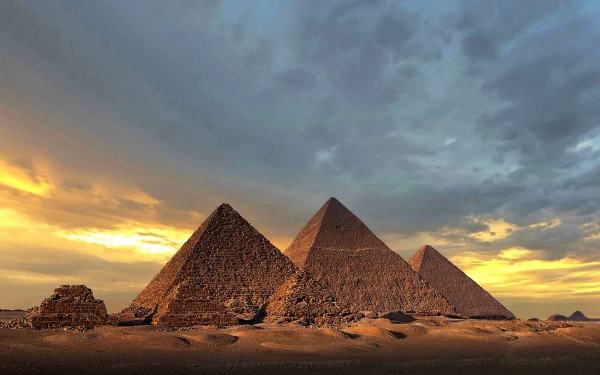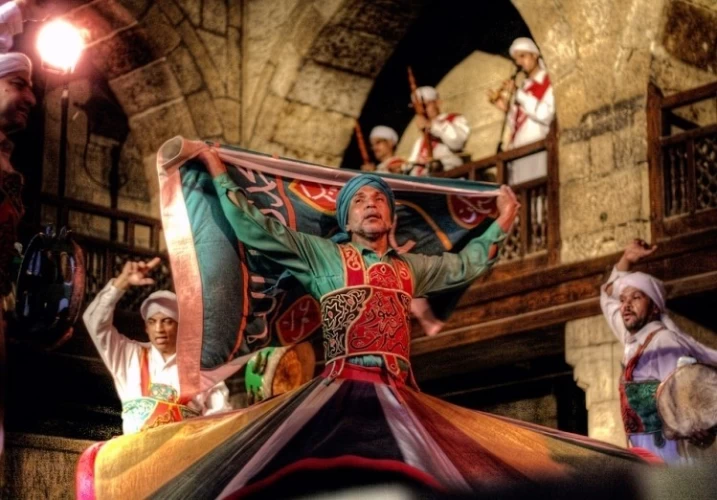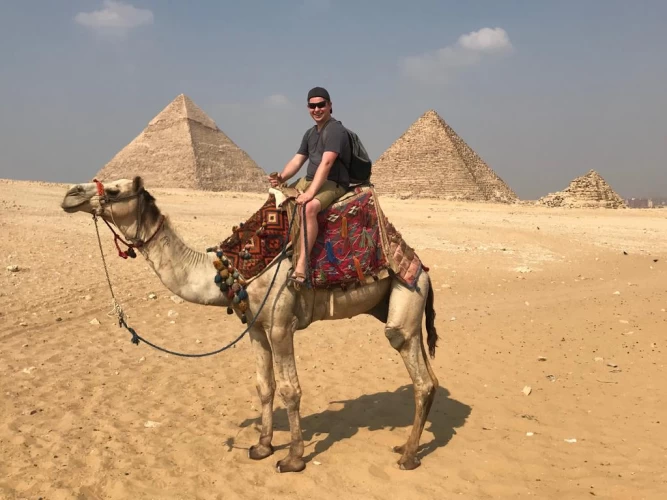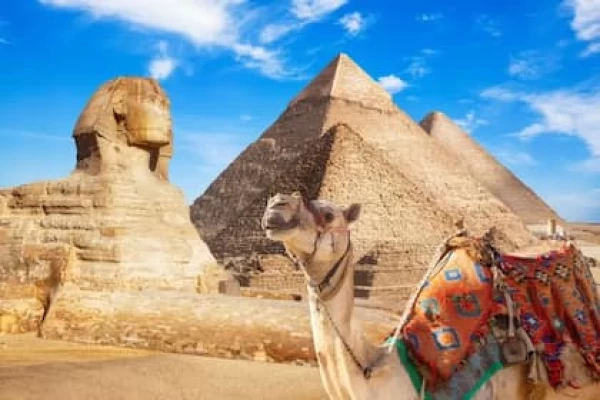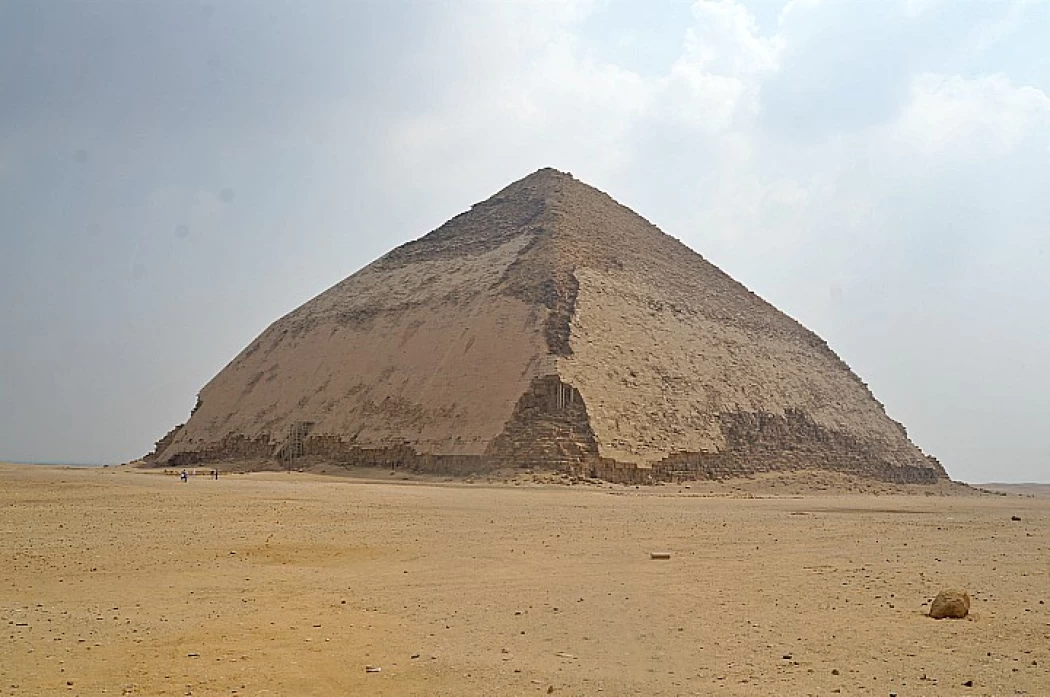
Myth Of The Great Pyramids / How The Great Pyramids Were Built?
The Giza Pyramid complex (also known as the Giza Necropolis), is an archaeological site in Egypt that includes the Great Pyramid, The Pyramid of Khafre, the Pyramid of Menkaure, as well as associated complexes and the Great Sphinx. These monuments were built during the era of the fourth dynasty of the Old Kingdom in ancient Egypt between about 2600 and 2500 BC. The site also includes several temples, tombs, and the remains of a workers ' village.
The complex is located on the edge of the Western Desert, about 9 kilometers (5.6 miles) west of the Nile River in the city of Giza, and about 13 kilometers (8.1 miles) southwest of downtown Cairo. The site forms the northern part of the pyramid fields covering an area of 16,000 hectares (160 square kilometers or 62 square miles) in Memphis and its Necropolis, inscribed on the UNESCO World Heritage list since 1979. These fields also include the complexes of the pyramids of Abu Sir, Saqqara, and Dahshur, built near the ancient Egyptian capital Memphis. It also includes other pyramid sites from the Old Kingdom at Abu Rawash, Zawiya Al-Arian, and Medium.
The Great Pyramid and the Pyramid of Khafre are two of the largest pyramids built in ancient Egypt, and they have become famous symbols of ancient Egypt in the Western imagination. The Great Pyramid gained special fame during the Hellenistic era, as the Greek poet Antipater the pharmacist listed it among the Seven Wonders of the world. The Great Pyramid is the oldest of the Seven Ancient Wonders of the world and the only one that still stands today.
According to one hypothesis, the pyramids are royal tombs, each of which bears the name of the king who built it and was buried in it. Pyramidal construction is considered a stage of the development of Tomb architecture in ancient Egypt, as it began with a small underground pit that later turned into a chamber, and then into several rooms topped with a terrace.
Funerary architecture experienced a qualitative leap during the reign of the engineer Imhotep, the vizier of Pharaoh Djoser during the third dynasty, who designed the Step Pyramid of Saqqara, the first known pyramid in history. After that, King Sneferu, the founder of the Fourth Dynasty, made two attempts to develop the shape of the pyramid to take its full form. However, the results of the two attempts in Dahshur came with the appearance of two imperfect pyramids; one flattened the base, and the other took a smaller shape that was almost half the size of the first.
During the reign of King Khufu, engineer Humayunu was able to achieve the ideal pyramidal shape by building the Khufu Pyramid in Giza on an area of 13 acres. This was followed by the construction of the Khafre and Menkaure pyramids, thus completing the famous pyramid complex in Giza.
The Giza pyramid complex consists of the Great Pyramid, also known as the Pyramid of Cheops, which was built around 2580-2560 BC, the Pyramid of Khafre, which is smaller in size and is located a few hundred meters to the Southwest, and the pyramid of Menkaure, which is distinguished by its relatively modest size, and is also located a few hundred meters to the southwest. As for the Great Sphinx, it is located on the eastern side of the complex, and it is unanimously believed among Egyptologists that the head of the Sphinx represents the head of King Khafre.
Along with these main attractions, the complex includes several small outbuildings, known as the pyramids of the "queens", as well as bridges and temples.
King Cheops succeeded his father Sneferu,and his mother was Queen hatep-Haras I. The reign of Cheops dates back to about 2650 BC.M., and his abbreviated name is "Khnum Kho AF Oy", which means "Khnum is the one who protects me". Khufu is known as the builder of the greatest building on Earth, The Great Pyramid of Giza is the only surviving miracle of the Seven Wonders of the ancient world. The greatness of the pyramid is not limited to its massiveness, but also to its textured and impressive internal layout.
Built around the Great Pyramid is a necropolis that includes small pyramids dedicated to his wives and his mother, Queen Hatep Haras, as well as tombs in the form of terraces for members of the royal family and senior officials. The original height of the Great Pyramid was 146 meters, but now it is about 137 meters, while the rib of its base is 230 meters long. As for the weights of the stones used in the construction, they range from one ton to eight tons or more.
Despite the enormity of this grandiose construction, only a very small statue of King Cheops was found, measuring only about 7.5 cm in size and from late times. It is believed that in his time the King forbade the erection or carving of statues since no large-sized statues from this period have been found, except for one found hidden in the Tomb of Prince Ra-hatep and his wife. And, perhaps, the king himself wanted to start preventing the erection of statues. King Khufu named his pyramid "the sister of Khufu", i.e. "the horizon of Khufu", as a result of the religious changes that took place in his time. The researcher Stadelman explained that Khufu departed from the traditional Egyptian doctrine and proclaimed himself a God.
Khufu,
The pyramid of King Khufu has not spared destruction through the ages. The Sicilian historian Diodorus pointed out that the top of the Great Pyramid is a platform about 3 meters wide and two meters long, but it is likely that the top of the pyramid was not a platform, but a pyramid that was probably covered with gold. Also, part of the cladding of the pyramid was destroyed and lost.
The pyramid was surrounded by a wall, the remains of which still stand today on the eastern and northern sides at a distance of 20 meters from the base of the pyramid.
Khafre,
The pyramid complex of Khafre consists of a valley temple, a Sphinx temple, a passage, a funerary temple, and the pyramid of the King. The valley temple has resulted in the discovery of many statues of Khafre, where the archaeologist "Mariette" found many of these statues in a well on the floor of the temple in 1860. Additional statues were also found during the excavations conducted by" Siglin"(1909-1910)," Jonker"," Reisner", and" And Hassan". Also, the Khafre complex included five pits intended for boats, as well as a subsidiary pyramid containing a crypt.
The pyramid of Khafre seems larger than the pyramid of Cheops next to it due to its high location and steeper angle of inclination. However, it is smaller than the Cheops Pyramid in height and size. The pyramid of Khafre is characterized by the fact that it still retains a clear layer of casing stones at its top.
Menkaure,
The pyramid complex of Menkaure consists of a valley temple, a passage, a funerary temple, and the pyramid of the King. The valley temple previously housed several statues of King Menkaure, and during the Fifth Dynasty, a smaller frontal temple was added to it. The funerary temple also yielded several statues of Menkaure. The Pyramid of the King, which was completed around 2510 BC, contains three subsidiary pyramids known as the Pyramids of the Queens.
Of the four main monuments of the Giza Pyramid complex, the Menkaure Pyramid today is the only one that does not retain any of its original polished limestone casing.
Sphinx,
The history of the Sphinx dates back to the reign of King Khafre. During the New Kingdom, Amenhotep II dedicated a new temple to Huron-Harim-akht, and later rulers added to it.
Tomb of Queen khent Kaos I,
Khent Kaos I was buried in Giza. Her tomb is known as LG 100 and G 8400 and is located in the central field near the valley temple of Menkaure. The pyramid complex of Queen khent Kaos includes her pyramid, a boat pit, a valley temple, and a pyramidal city.
Construction,
The construction of the Great Pyramid took almost twenty years, while the construction of the corridors and the lower parts of the pyramid took ten years, according to the Greek historian Herodotus, who visited Egypt in the IV century BC, that is, more than two thousand years after the construction of the pyramid. Herodotus listened to these and other accounts of some priests and narrators.
The stones used in the construction of the Great Pyramid were cut from the surrounding area, the outer clothing stones were brought from the area of Jabal Torah, while the granite stones used in the inner rooms were brought from the quarries of Aswan. It was transported across the Nile River, which was reaching the pyramid area at that time.
The stones were cut and separated from each other by making converging holes in the piece of stone to be cut, and then hammering wooden pegs inside these holes, putting water on them. The more the wood drinks the water, the larger it becomes inside the stone, and as the knocking on the wedges continues, the stones separate from each other. After that, they are polished and polished using some kind of hard stone, such as granite or diorite.
The ancient Egyptians used innovative methods of building the pyramids, relying on a sandy road on which pieces of Stone were placed on wooden skis, and at the bottom of which were round palm trunks that served as wheels. These skis are pulled with ropes and oxen, sprinkling water on the sand to facilitate the towing process. The higher the height of the Masonry, the greater the amount of sand used until reaching the top of the pyramid. After that, the pyramid is clad with smooth limestone starting from the top to the base with the sand gradually removed.
The ancient engineering achievements, including the pyramids of Giza, are so impressive that even today scientists and engineers cannot be sure exactly how the pyramids were built, and yet they have learned a lot about the people who built them and about the political power necessary to achieve this.
The builders were skilled Egyptian workers living in a nearby temporary city spread over an area of 17 acres, while the remains of bakeries and piles of animal bones show that they were fed very well for their work, while archaeological excavations at the magnificent site revealed a highly organized, resource-rich society, which must have been supported by a strong central authority.
Archaeological sites throughout Egypt and written records on ancient papyri show that boatmen used the Nile River and a network of artificial waterways to bring materials to the Giza Plateau, including granite from Aswan quarries, copper-cutting tools from the Sinai Peninsula, timber from Lebanon and to support workers, they also delivered livestock from farms near the Nile Delta according to the National Geographic website.
Communities throughout Egypt likely contributed workers, as well as food and other necessities, in what in some ways became a national project to showcase the wealth and control of the ancient pharaohs.
Scientists and engineers are still discussing how the pyramids were built, it is generally believed that the Egyptians transported huge stone blocks to the heights along large slopes, greased with water or wet clay, using a system of skis, ropes, pulleys, and cranes, some suggest external slopes either zigzag or spiral around each pyramid, while a more controversial theory suggests that internal slopes were used.
The secrets of building these pyramids may lie beneath the surface, and when future imaging technology reveals the arrangement of the blocks inside, it will provide a blueprint for how Egyptian builders created these timeless monuments.
Peter Der Manuelian, an Egyptologist at Harvard University, says, "Many people think that the site is just a tomb in the modern sense, but it's much more than that in these ornate tombs, you have wonderful scenes of every aspect of life in ancient Egypt, so it's not just about how the Egyptians died, but a question: how they lived.
The art of the tombs includes images of ancient farmers working in their fields, caring for livestock, fishing, hunting birds, practicing carpentry, wearing costumes, and performing religious rituals and burial practices.
Inscriptions and texts also allow searching the Egyptian Grammar where the Manuelian monastery says:"Almost any topic you want to study about the Pharaonic civilization is available on the walls of the tombs in Giza".
Why the hierarchical form?
The pyramid form among the ancient Egyptians was associated with the idea of the origin of the universe and they also believed, according to some of their writings and religious texts, that the pyramid is a means that helps the soul of the deceased to reach heaven with the idol Ra. We also see the pyramidal shape on top of obelisks and some small tombs of individuals in southern Egypt, even when the Kings of the new kingdom thought about building their tombs on the western mainland in the valley of the Kings and tapping them into the bottom of the mountain to protect them from theft, they did not abandon the pyramidal shape, which was naturally represented at the top of the mountain itself.
The Construction Mechanisms of the Pyramids: Estimating the Engineering Feats of the Ancient Egyptians
The Giza Pyramids are some of the greatest buildings that were ever designed and built, and the workforce that existed in those days was just extraordinary and incredible. These massive structures, particularly the Giza period pyramid, have puzzled historians, archeologists, and engineers for many ages, imbued with the perennial query of how such structures were even raised in the first place. These constricting structures were lifted by ancient people exercising modern-day power, construction engineering, and most fundamentally, physics and material science.
In this paper, let us specifically deal with the Giza Pyramids, their construction and techniques that were employed, the tools brought in, and the people present in the country.
The Workforce Behind the Pyramids: Myth vs. Reality
A widely held belief that the Pyramids were built by slaves has been proven to be false by recent studies. The Great Pyramid of Cheops (Khufu), which was constructed within the fourth dynasty of Old Kingdom Egypt, was constructed by skilled laborers and not by slaves. Estimates have suggested that between 20,000 and 30,000 men took part in the construction work, and this lasted about twenty-three years.
Rather than being enslaved, these workers received proper payments for their work. More so, they were also given accommodation, food, and clothing in return for their services, which included a tax waiver. These were aimed at ensuring that they took part actively in the building of the pyramid for as long as it took and appreciating their input.
Instruments and Components
The builders of the pyramids may have had a whole arsenal of cutting and measuring tools to cut and shape the large die stones, which are the building blocks of the pyramids. However, while the shell of most pyramids was built of limestone, the core of these structures was more advanced materials, especially granite, which required more sophisticated tools. There was a granite hammer to first carefully shape the rock statues, a few basic copper chisels, and other items that were quite artistic with stone engraving.
One of the main challenges in the process of building the pyramids was that they not only had to be built, but there were massive stone slabs to be carried, which weighed about 15 tons each, among others. It is believed that the ancients would use wooden sleds and load the stone blocks on them and then drag the blocks over the sand. Watering the sand ahead of the sleds was another technique since this reduced the resistance to pulling the stones. Studies revealed that this method of wetting the sand can help reduce the force of pulling by as much as fifty percent, making it very convenient to move heavy stone blocks.
The Use of Ramps in Pyramid Construction
One of the most fascinating techniques that the Egyptians used in the construction of the pyramids was the application of ramps. Workers made use of rampways made of mud bricks with a coating of wax chips to enhance the durability of the surface. These ramps enabled the workers to pull the heavy stone blocks to the higher levels of the pyramid and, more so, to position them correctly.
This process would be repeated layer after layer of stones until the pyramid reached its full height, with additional ramps being constructed to enable the lifting of stones. These ramps played an important role in the whole process of construction, and remains of such ramps have been discovered in other parts of Egypt, including temples like the Karnak Temple in Luxor and an incomplete pyramid from the period of Djedefre, both from the Old Kingdom.
The historical ramps' construction principles have neither been agreed upon nor dismissed by historians and engineers. Some contend straight “runners” could be built on one face of the pyramid; others contend a more complicated set of systems, including zigzag-forming runners or even runners that wrapped around the pyramid. In whatever shape, designed, and built, these ramps were major for moving the heavy stone blocks to the more elevated sections of the pyramid.
The most interesting thing about the Giza Pyramids is the way they were built perfectly, and their alignment was unquestionable. The Great Pyramid has its sides aligned to face the four cardinal points of the compass with unimaginable precision, a task that would be beyond someone who didn’t understand geometry and astronomy at an advanced level.
To avoid the bulging of the pyramid while building it, the ancient Egyptians probably made use of various measuring devices like plumb lines and set squares. The sharpness of the design is illustrated by the almost equal size of the base and the extreme rise of
the sides of the pyramid, which remain unchanging even at higher levels.
For many centuries, the successful execution of this alignment has been a subject of admiration and wonder. The angles are strikingly accurate, and the mathematical proportions of the construction allow one to understand why the ancient Egyptians were geometry masters and how to build from the bottom of the pyramid to its peak while preserving its shape.







